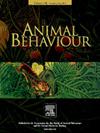黑腹果蝇交配持续时间的性冲突
IF 2.3
2区 生物学
Q2 BEHAVIORAL SCIENCES
引用次数: 0
摘要
交配时间在物种之间和物种内部差别很大,通常持续的时间比精子转移所需的时间更长。长时间的交配在能量上是昂贵的,并且需要时间和资源,否则这些时间和资源可以用于其他地方,因此延长的交配可能给两性中的一方或双方带来的好处超过了这些成本。在果蝇(Drosophila melanogaster)中,交配时间主要由雄性控制,并在精子转移结束后继续。尽管有证据表明交配持续时间可能会影响该系统中与适合度相关的特征,但研究自然发生的交配持续时间变化对雄性和雌性影响的对照实验缺乏。我们用半克隆分析研究了长、短交配半克隆系的雄性与不同大小的雌性进行长时间交配对两性的影响。与交配时间较短的雄性相比,交配时间较长的雄性与体型较小的雌性交配的后代比例更高(即防御性繁殖成功率更高),这表明雄性从延长的交配中获益。相比之下,较长的交配时间对雌性有害,因为无论是大雌性还是小雌性,与长交尾半克隆系的雄性交配后的繁殖力都明显低于短交尾半克隆系的雄性。我们的研究结果表明,交配持续时间参与了黑腹龙的性冲突,为物种内维持交配持续时间变化的机制提供了洞见。本文章由计算机程序翻译,如有差异,请以英文原文为准。
Sexual conflict over mating duration in Drosophila melanogaster
Mating duration varies widely between and within species, often lasting longer than is necessary for sperm transfer. Prolonged copulations can be energetically expensive and take time and resources that could otherwise be directed elsewhere, so extended matings likely provide benefits to one or both sexes that outweigh these costs. In the fruit fly, Drosophila melanogaster, mating duration is primarily under male control and continues after sperm transfer has ended. Although there is evidence that mating duration may affect fitness-related traits in this system, controlled experiments investigating the impacts of naturally occurring variation in mating duration on both males and females are lacking. We used hemiclonal analysis in D. melanogaster to investigate the consequences of prolonged matings for both sexes by mating males from long- and short-mating hemiclone lines to females of varying sizes. Males with longer mating durations sired a greater proportion of offspring (i.e. had higher defensive reproductive success) with small females than males with shorter mating durations, indicating that males benefited from prolonged matings. In contrast, longer matings were harmful to females, as both large and small females had significantly lower fecundity after mating with males from long-mating hemiclone lines compared to males from short-mating hemiclone lines. Our findings demonstrate that mating duration is involved in sexual conflict in D. melanogaster, providing insight into the mechanisms maintaining variation in mating duration within species.
求助全文
通过发布文献求助,成功后即可免费获取论文全文。
去求助
来源期刊

Animal Behaviour
生物-动物学
CiteScore
4.60
自引率
8.00%
发文量
236
审稿时长
10.2 weeks
期刊介绍:
Growing interest in behavioural biology and the international reputation of Animal Behaviour prompted an expansion to monthly publication in 1989. Animal Behaviour continues to be the journal of choice for biologists, ethologists, psychologists, physiologists, and veterinarians with an interest in the subject.
 求助内容:
求助内容: 应助结果提醒方式:
应助结果提醒方式:


